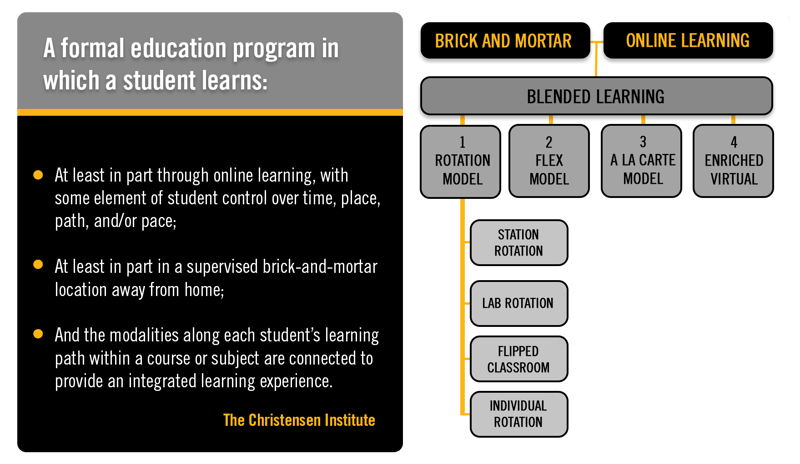Next Generation Blended Learning
It’s time to reimagine blended learning to take full advantage of today’s teachers, technology, and new instructional strategies.
When the book Disrupting Class was published in 2008, it changed the discussions about blended learning and indeed shifted all of digital learning. Prior to the work of the Clayton Christensen Institute and the book’s authors, blended learning was generally understood to refer to the use of technology in physical classrooms. That meant a lot of different ideas to different people.
Disrupting Class set forth a definition and a taxonomy. The definition:
A formal education program in which a student learns:
- At least in part through online learning, with some element of student control over time, place, path, and/or pace;
- At least in part in a supervised brick-and-mortar location away from home;
- And the modalities along each student’s learning path within a course or subject are connected to provide an integrated learning experience.
The Christiansen Institute

Graphic adapted from: Christensen Institute. (n.d.). Blended Learning Definitions and Models. https://www.christenseninstitute.org/blended-learning-definitions-and-models/
The rotation model was built around students “rotating” between teacher-led instruction and computer-mediated learning, with students going through computer stations, or to computer labs, or the teacher “flipping” the classroom by assigning online homework to teach basic skills and ideas, and using physical classroom time to take on harder issues in small group discussions and tutoring. The other models—flex, a la carte, and enriched virtual—were all variations on primarily online courses with some face-to-face support (although with flex having more onsite support than the others). The rotation model became the commonly understood approach to most K-12 blended learning in the United States.
Fifteen years ago, the spread of these definitions and models moved the digital learning field forward. The models quickly became familiar to many teachers and school leaders, especially in states in which districts were feeling competition from online charter schools. The definition gave educators a common language, and the models made professional development much easier to provide because everyone could agree on what the teacher was supposed to do in each case.
But over time, what had been a useful starting point became a burden. Why? Because for too many traditional schools, “blended learning” came to be defined by a narrow set of instructional strategies that constricted the roles of teachers and the function of what was thought of as computer-mediated instruction. The student time on computers was often relegated to drill-and-skill, remediation, and other low-value activities.
It's beyond time for a new approach, because teachers can do more, and students expect better. We see this new approach in many innovative schools, but we also see too many schools being held back by outdated “blended learning” thinking.

What does the new blended learning look like? Some examples include:
- What was low-value time on a computer, is now high-value time in which the student has increased agency over their path. Some of this is due to the far higher quality digital content and technology than existed fifteen years ago; more of the change is due to the evolving roles that some teachers are now taking on ever more skillfully. Rarely do teachers lecture large groups of students in the best hybrid schools, and rarely do students click through repetitive content (if the school has chosen high-quality online materials).
- In elementary schools, adaptive math and reading content assesses students and provides teachers with student-specific, actionable data to help each student move to their zone of proximal development. Teachers use simple and consistent formative assessments to target instruction to individuals and small groups.
- In high schools, students take increasing control of their learning paths, including combining their traditional courses with dual credit courses, jobs, and internships—or other non-academic pursuits.
- Teachers oversee projects, allowing students to learn how to work together and collaborate as many professionals do in the working world.
- Career and technical education includes online courses that carry credentials for students who are able to demonstrate mastery. Other CTE courses are largely hands-on (think health care or HVAC systems), and students have more time in work settings or maker spaces because they have online courses which free up time in their schedules.
The main difference between blended learning then, and digital learning now, is that with the evolution of technology and teaching, instructional practices and technology resources can be used differently. This doesn’t mean they never have face-to-face time with a teacher. Instead, it means that face time is highly valued and maximized to address some of the most difficult issues and persistent challenges that cause students to struggle. The flip side is that the student-controlled time allows students to develop their curiosity and pursue their interests.
If your school is still stuck on the 2008 version of blended learning, we invite you to let us show you what digital learning can look like in 2023.
With over 20 years of experience, StrongMind supports next-generation blended learning in a number of ways — high-quality K-12 digital courses, SEL, implementation and training support, and meaningful data to keep all stakeholders informed. Students using StrongMind digital courses thrive with opportunities for collaboration, real-world application of knowledge, and research-based pedagogy that keeps students engaged and on track.
